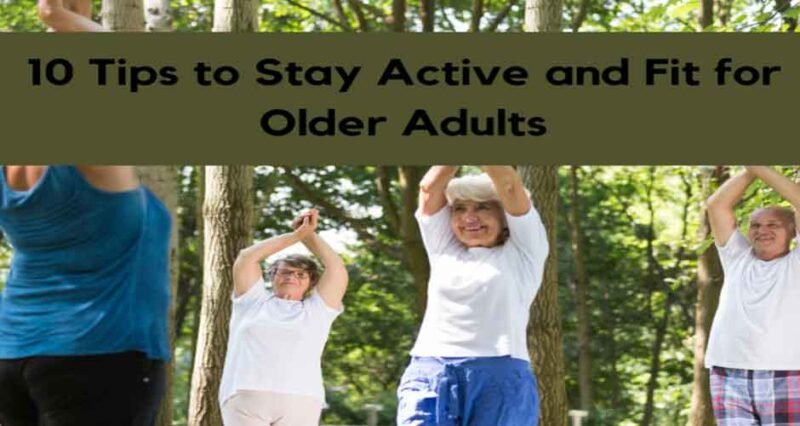
Staying physically active is one of the most important things older adults can do to maintain their health. Engaging in exercise improves the quality of life. Regular activity reduces the risk of chronic diseases like heart disease, diabetes, and cancer significantly. Moreover, staying active promotes emotional well-being. This is achieved by reducing symptoms of anxiety and depression.
In this article, we provide 10 practical tips to help older adults stay active and fit:
1. Engage in Low-Impact Cardio Exercises
Low-impact aerobic activities like walking, swimming, and cycling are gentle on the joints. While providing tremendous cardiovascular benefits. Quality long-term senior care should include low-impact exercise.
One way to incorporate it is through walking. According to a study by Harvard, walking just 30 minutes a day can slash heart disease risk by 30%. Other suitable options include water aerobics and seated exercises.
Aim for at least 150 minutes per week of moderate cardio activity, like brisk walking.
2. Incorporate Strength Training
Muscle mass declines by 3-8% per decade after age 30. This underscores the vital role of strength training for older adults. Lifting light weights and doing bodyweight exercises help maintain strength to support daily activities. It can also improve bone health. Include resistance training in your routine at least two days per week.
Strength training for just 30 minutes twice a week can preserve muscle mass and function.
3. Practice Tai Chi to Improve Balance
The slow, graceful movements of Tai Chi enhance flexibility, strength, and balance. These help prevent falls. Per the Journal of the American Geriatrics Society, practicing Tai Chi reduced fall risk by a sizable 43% in seniors. It also provides relaxation benefits.
Only 15 weeks of Tai Chi training can significantly reduce falls in older adults.
| Type | Benefits | Examples |
| Aerobic | Improves heart health | Brisk walking, water aerobics, and seated exercises |
| Strength | Builds muscle and aids daily tasks | Light weights, Pilates, and Tai Chi |
| Flexibility | Enhances range of motion | Yoga, stretching, and Tai Chi |
4. Stretch Regularly to Improve Flexibility
Flexibility naturally diminishes with age, increasing the risk of injury. Regular stretching can boost flexibility by 30% while keeping muscles relaxed. Simple daily stretches for the legs and back go a long way toward maintaining range of motion. Increasing flexibility can lower the risk of falls and improve movement.
Just 5 to 10 minutes of stretching per day can preserve flexibility and prevent painful muscle strains.
5. Prioritize a Nutritious, Balanced Diet
Good nutrition provides energy for an active lifestyle. It also helps prevent age-related issues like nutrient deficiencies and unwanted weight changes. Nutrient rich diets can also improve health and prevent long term disease.
According to a study by the National Library of Medicine, a significant increase in vitamin B can slow down brain atrophy by 40%. Emphasize fruits, vegetables, whole grains, lean protein, and healthy fats in your diet. Stay hydrated too, as dehydration can impair cognitive function.
Proper nutrition sustains activity levels and boosts the immune system.
6. Consult a Health Provider About Exercise Plans
Each senior has unique health considerations. It is important to consult physicians and develop personalized exercise regimens. As the population of seniors rises, it is best to consult with your healthcare provider about individual needs. This is done to complement medical conditions and address mobility levels.

Seeking guidance from healthcare professionals ensures safety and maximizes the benefits of exercise.
7. Respect Pain Signals and Listen to Your Body
As we age, paying attention to bodily feedback becomes crucial. Know when to modify or stop an activity if it causes pain. Start slowly after an illness or injury, respecting your own pace.
Carefully monitoring exercise intensity prevents injuries from overexertion in older adults.
8. Incorporate Enjoyable Group Activities
Group exercise classes provide social stimulation along with physical benefits. Participating in activities like Zumba and water aerobics and staying active with others also helps cognitive function.
One study linked an active social lifestyle to a lower risk of cognitive decline, as reported by the World Health Organization.
Local community centers offer affordable group classes catering to older adults.
Social engagement through exercise combats isolation while promoting brain health.
9. Take Up a Hobby or Leisure Activity
Integrating physical activities like gardening into your routine encourages consistent activity through enjoyment. Research shows that just 30 minutes of hobbies daily reduces the risk of heart disease and stroke. Additional options include leisurely biking, light hiking, and active gaming.
Hobbies that keep seniors moving also provide stress relief and a sense of purpose.
10. Start Slowly and Focus on Consistency
When starting a new activity, begin gradually at an easy pace and slowly increase duration and intensity. Small starts prevent soreness and frustration. The key is to remain consistent, listening to your body and taking rest days as needed, rather than pushing excessively hard. Every little bit counts.
Gradual progression allows the body to adapt without overtaxing muscles or joints.
Frequently Asked Questions
How much exercise do older adults need?
The World Health Organization recommends at least 150 minutes per week of moderate-intensity activity. Some activities include brisk walking, water aerobics, or cycling. This accumulates to 30 minutes five days per week. Also aim for muscle-strengthening twice a week. Also, include balance exercises three times per week.
Which exercises help with chronic conditions like arthritis?
Low-impact activities like walking, water workouts, and stretching help ease arthritis pain. Always check with your physician first regarding exercise for medical conditions. T’ai Chi also helps reduce arthritis disability by nearly 50%.
Can staying active mitigate pain from aging conditions?
Yes, regular activity lowers pain and disability from common age-related issues like osteoarthritis and back pain. Exercise strengthens muscles supporting joints while lubricating cartilage and stimulating pain-relieving endorphins. However, some conditions, like osteoporosis, require care to avoid fractures.
Final Takeaway
Maintaining an active lifestyle provides immense benefits for the body and mind in seniors. Staying physically and socially engaged lowers early mortality risk. Hopefully these evidence-based tips give older adults the encouragement and practical advice they need to make regular exercise an enjoyable, sustainable part of healthy aging.
Remember to start with low intensity and progress slowly. The rewards of improved strength, cardiovascular function, balance, flexibility, and wellness are well worth the effort.

